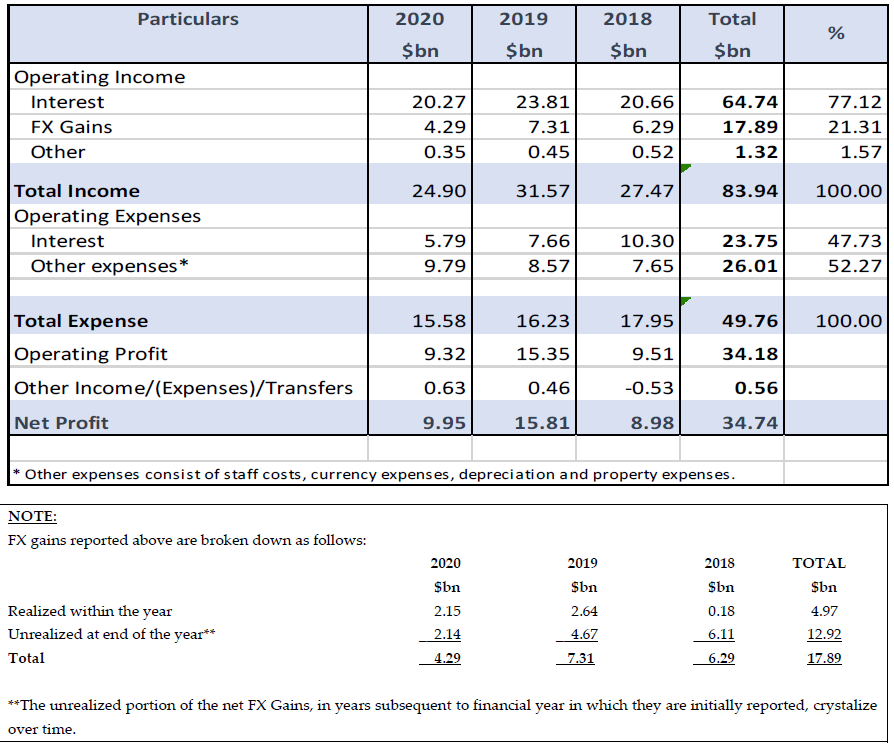
 Understanding Bank of Jamaica Profits
Understanding Bank of Jamaica Profits
by Governor Richard Byles
On 01 April 2021, Bank of Jamaica (BOJ), in accordance with the Bank of Jamaica Act, made a distribution to the Government of Jamaica of $32.6 billion from accumulated profits for the period 2018-2020 less unrealized gains as at 31 December 2020. Such a transaction is already routine for many modern central banks but, for Jamaica, appeared significant because it was unprecedented.
This article sheds light on the sources of these profits and important features of BOJ’s future financial relationship with the GOJ.
HOW ARE BOJ PROFITS GENERATED?
As with any other entity, BOJ profits are the residue of income from operations after deducting the recurrent expenses incurred in generating that income over a given reporting period.
The Bank by statute is charged with the responsibility for carrying out a number of functions. Some of those functions are:
- the maintenance of monetary stability in Jamaica;
- the issuance and redemption of notes and coins (i.e., the national currency); and
- the holding and management of the international reserves of Jamaica.
Given its functions and the structure of its balance sheet, BOJ’s main sources of income are the interest that it earns on its foreign and local currency denominated assets and, to a much lesser extent, foreign currency gains that arise from (a) the purchase and sale of foreign currency and (b) revaluation of foreign currency assets.
BOJ’s expenses typically include interest payments on its liabilities, expenses incurred in relation to issuing and redeeming currency, foreign exchange losses, staff related costs, depreciation of fixed assets, repairs and maintenance costs related to equipment used, utilities expenses, etc.
The table below presents the size of the Bank’s income, expenses and profits for the three-year period 2018 – 2020:

The Bank’s operating income over the period averaged close to $28 billion per year (or 1.4% of GDP), of which net FX gains averaged just under $6.0 billion per year and represented only 21% of overall annual earnings. Expenses on the other hand averaged close to $17 billion per year, of which interest expenses represented close to a half of this amount.
Two observations arise from these numbers. The first is that, by far, net interest income (the difference between interest income and interest expenses) is the largest contributor to BOJ’s profits over the 3-year period. Net interest income in aggregate was almost $41 billion for the three-year period, which is equal to 121% of net profits (this is an average of $13.7 billion per year). The second observation is that the portion of FX Gains realized within the financial years (i.e., gains from trading and liquidation of positions) only averaged $1.7 billion, which in aggregate is $4.97 billion or approximately 5.9% of the Bank’s total income for the period. These realized net gains arise primarily from transactions with the Government and local financial institutions including interventions made by the central bank in the FX market in an attempt to maintain orderly conditions in that market.
A fair question to ask is: what are BOJ’s assets and liabilities which have led it to realising positive net interest income? BOJ acquires domestic securities (assets) in the context of its transactions with the Government and with the banking system. Two recent examples of these transactions are:
(1) our acquisition of close to $50 billion in GOJ securities from deposit taking institutions and securities dealers in 2020 in the context of the Bank’s initiative to maintain adequate levels of liquidity in the financial system to ensure that it could withstand the impact of the Covid-19 pandemic; and
(2) the provision by the GOJ of securities amounting to $51 billion to (a) cover the Bank’s past losses as required by law and (b) to inject fresh capital into the Bank, preparatory to the passage of the Bank of Jamaica (Amendment) 2020 Act. Between 2010 and 2017, the Government owed BOJ $31 billion for accumulated losses. These losses were settled in 2018 and 2019.
In relation to its foreign assets, BOJ, for very important reasons, buys FX from either the GOJ or the financial system, or borrows from the IMF. Holdings of these foreign currency assets are important for Jamaica in the event of a shock that reduces her ability to earn foreign currency. The country’s reserves are there to support critical purchases of supplies from abroad. They are also important to ensure that the GOJ can meet its external debt obligations without interruption and, finally, they underwrite relative stability in the foreign exchange market in the context of temporary gaps or disjuncture between receipts and payments of foreign currency by the private economy.
BOJ’s liabilities (both FX and JMD denominated) arise in the normal course of its business of conducting open market operations.
The next issue to clarify is why has BOJ started to make profits whereas before it was making losses. The answer is partly found in the fact that BOJ’s interest earning assets have been growing over time, which I have explained above. The other part of the answer lies in the fact that interest rates on the Bank’s liabilities have fallen significantly over the past ten years. This reduction reflects the impact of several factors. First, in the context of the Bank’s de-facto adoption of an inflation targeting regime and the fact that inflation has been contained, we have been able to reduce the interest rate on our policy instruments progressively over the past ten years to historic lows. Secondly, in years past, large fiscal deficits and an over- dependence by the GOJ on borrowing, created an economic environment that necessitated high interest rates to maintain economic stability. Better fiscal discipline in recent years, reflected in a notable debt reduction, has therefore set the pre-conditions for BOJ to aggressively reduce interest rates.
What Will Happen in the Future?
The original Bank of Jamaica law stated that BOJ profits should be turned over to Government and that, conversely, when BOJ makes a loss, the Government must cover that loss. Going forward, the amended Bank of Jamaica Act has significantly changed the regime under which BOJ will make dividend payments to the GOJ. In this new regime, BOJ’s relationship with the Government will be guided by the level of its capital in relation to its “monetary liabilities”. If BOJ’s capital to monetary liability ratio (or CMLR) is above certain prescribed levels, the BOJ will pay stipulated portions of its previous year’s profits (or more technically its “distributable earnings”) to the GOJ. If the CMLR is below another prescribed level, however, the GOJ will be required to recapitalise the Bank to attain a minimum capital to monetary liability ratio of 3% by providing it with marketable securities. In the context of this new regime, it is not very likely that a large dividend payment such as the one made on 01 April 2021 will flow to the GOJ over the next few years. Notwithstanding, once the statutory conditions allow, the BOJ will continue to make distributions to the GOJ from time to time.
Richard Byles
Governor, Bank of Jamaica
Editorial note: This article was published in the Jamaica Observer: https://bit.ly/3xyHu6W








